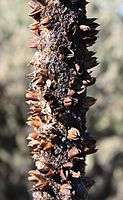Xanthorrhoea preissii
Xanthorrhoea preissii, known as balga, is a widespread species of perennial monocot in Southwest Australia.
| Xanthorrhoea preissii | |
|---|---|
 | |
| Scientific classification | |
| Kingdom: | Plantae |
| Clade: | Tracheophytes |
| Clade: | Angiosperms |
| Clade: | Monocots |
| Order: | Asparagales |
| Family: | Asphodelaceae |
| Subfamily: | Xanthorrhoeoideae |
| Genus: | Xanthorrhoea |
| Species: | X. preissii |
| Binomial name | |
| Xanthorrhoea preissii | |
| Synonyms | |
| |
Description
The form of the plant resembles a tree, with very long and bunched, grass-like, leaves that emerge from a central base.
The trunk may grow over 3 metres tall, and the often blackened appearance is evidence of its ability to withstand fire. The remains of the flammable leaves and the annual regrowth produce banding, allowing the age of the plant to be determined, and giving a record of previous fires in its habitat. The inflorescence appears on an upright spike, 1.5 m to 2.5 m long, between June and December. The sessile flowers, creamy or white, appear more profusely when stimulated by bushfire.[2]
Taxonomy
The name 'balga' is derived from the Nyungar language. This species and other members of the genus Xanthorrhoea are informally termed blackboys or grasstrees.[3] The appearance of the plant was seen as resembling a native inhabitant holding a spear, by the early settlers of the region, leading to the common name blackboy.[4] Today, this term is considered inappropriate.
A description published in 1920, Xanthorrhoea reflexa D.A.Herb., is cited as a taxonomic synonym for this species, as is the name Xanthorrhoea pecoris F.Muell.[5][6] The species description was first published by Stephan Endlicher in the 1846 volume of Plantae Preissianae.[7]
Distribution
It is found throughout coastal plains, near watercourses, and inland forest regions, in a range extending from Geraldton to Albany and in the Avon Wheatbelt. It occurs on a wide variety of soil types and is sometimes associated with laterite and granite.[1]
Ecology
The species is named as one of the dominant taxa in Corymbia calophylla – Xanthorrhoea preissii woodlands and shrublands of the Swan Coastal Plain, a critically endangered ecological community, once widespread and now restricted to a narrow range. Its occurrence is a characteristic of two other marri (Corymbia calophylla) communities, but the marri/Xanthorrhoea community is distinguished by the drier soils of the communities range along the eastern edge of the Swan Coastal Plain.[8]
Uses
The species had a high economic importance to the Noongar people, who named it balga, utilising the gum it contains, the spike for fish spears, and the bardi grub as a source of food. Anecdotal information on the species refers to an association with fire in the culture of those people.[2]
Gallery
 Closeup of flower spike
Closeup of flower spike
 British Museum display (May 2010)
British Museum display (May 2010) Xanthorrhoea with full leaf skirt
Xanthorrhoea with full leaf skirt
References
- "Xanthorrhoea preissii". FloraBase. Western Australian Government Department of Parks and Wildlife.
- Ward, D J; Lamont, B B. "Probability of grasstrees (Xanthorrhoea preissii) flowering after fire" (PDF). Journal of the Royal Society of Western Australia (83): 13–16. Archived from the original (PDF) on February 21, 2011.
- "Pastoral-Agricultural; Agricultural Notes". Friday 17 August 1906. Morning Bulletin (Rockhampton, QLD). 1906-08-17. Retrieved 2019-01-07.
- Gardner, C.A. (1981). Wildflowers of Western Australia. Perth: St George Books. p. 10. ISBN 0-909699-01-1.
- "APNI - Xanthorrhoea preissii". biodiversity.org.au. Retrieved 17 October 2018.
- "World Checklist of Selected Plant Families". The Board of Trustees of the Royal Botanic Gardens, Kew. Retrieved 2011-06-27. Cite journal requires
|journal=(help) - Lehm., Plantae Preissianae 2:39 (1846)
- "Corymbia calophylla – Xanthorrhoea preissii woodlands and shrublands of the Swan Coastal Plain". Threatened species & ecological communities. Department of the Environment, Water, Heritage and the Arts. 19 Feb 2007. Retrieved 2009-05-31.
External links
| Wikimedia Commons has media related to Xanthorrhoea preissii. |